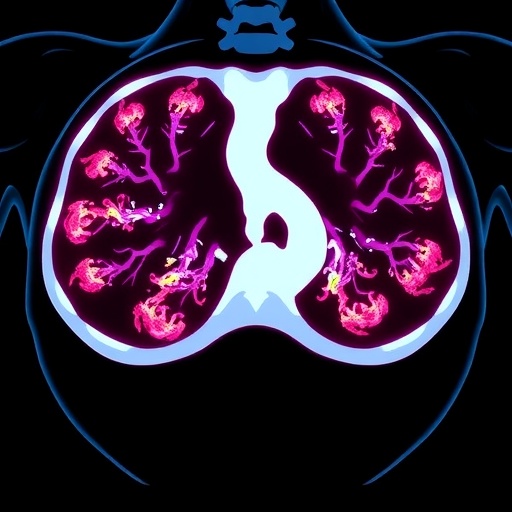In a groundbreaking advancement within oncology research, scientists have unveiled novel techniques capable of detecting vascular normalization in epithelial ovarian cancer, offering a revolutionary perspective on tumor microenvironment assessment and therapeutic efficacy. This breakthrough paves the way for more precise and individualized treatment strategies, challenging existing paradigms in cancer diagnosis and management.
Epithelial ovarian cancer (EOC), notorious for its poor prognosis and high mortality rates, owes much of its complexity to the dynamic nature of tumor vasculature. Tumor blood vessels often present as aberrant, tortuous, and dysfunctional networks, contributing to hypoxia, immune evasion, and ineffective drug delivery. The concept of vascular normalization, originally proposed over a decade ago, revolves around the restoration of the tumor vasculature towards a more “normal” phenotype, which not only improves perfusion but also enhances the delivery of chemotherapeutic agents and immune cells into the tumor core.
Detecting this vascular normalization phenomenon in vivo remains a formidable challenge due to the heterogeneous and transient nature of vascular remodeling. Traditional imaging and histological techniques often lack the resolution or specificity to effectively differentiate between normalized and abnormal vasculature. In this context, the recent study spearheaded by da S. Mororó and colleagues, published in Medical Oncology, introduces sophisticated methodologies for identifying vascular normalization status through integrative diagnostic approaches.
.adsslot_mFtAna7kwr{ width:728px !important; height:90px !important; }
@media (max-width:1199px) { .adsslot_mFtAna7kwr{ width:468px !important; height:60px !important; } }
@media (max-width:767px) { .adsslot_mFtAna7kwr{ width:320px !important; height:50px !important; } }
ADVERTISEMENT
Central to these advancements is the employment of multiparametric imaging modalities combined with molecular biomarkers that meticulously characterize vascular structure and function. The researchers harnessed state-of-the-art contrast-enhanced ultrasound alongside dynamic contrast-enhanced MRI, which synergistically provided high spatial and temporal resolution insights into blood flow, vessel permeability, and interstitial pressure variations within tumor tissues. This multi-modal imaging framework allowed for a comprehensive depiction of the vascular network’s morphological and functional properties.
Complementing imaging techniques, the team employed circulating biomarkers reflective of endothelial activation and normalization states, such as angiopoietins and vascular endothelial growth factor (VEGF) isoforms. By correlating these molecular readouts with imaging data, the researchers established a robust profile indicative of vascular normalization. This integrative methodology marks a significant leap, transcending the limitations of single-parameter assessments that have historically impeded clinical translation.
The clinical implications of detecting vascular normalization in epithelial ovarian cancer are profound. Normalization of the vasculature has been linked to enhanced delivery and uptake of chemotherapeutic agents, reduction of hypoxic niches that foster aggressive cancer phenotypes, and modulation of the immune microenvironment towards increased lymphocyte infiltration and activity. Consequently, being able to pinpoint the temporal windows during which the tumor vasculature is normalized can enable oncologists to strategically time therapeutic interventions, maximizing efficacy while minimizing systemic toxicity.
Moreover, vascular normalization detection augments the ongoing efforts in precision medicine. Not all tumors respond uniformly to anti-angiogenic therapies; some may exhibit transient or partial normalization, while others may develop resistance through alternate angiogenic pathways. The methodologies developed by da S. Mororó’s team allow for real-time monitoring of vascular changes, thus providing critical feedback on treatment response and facilitating adaptive therapeutic regimens.
Notably, the study elucidates how vascular normalization status correlates with patient outcomes. Preliminary clinical data suggest that patients exhibiting sustained vascular normalization patterns post-therapy demonstrate improved progression-free survival and overall prognosis. This reinforces the potential utility of vascular normalization as a prognostic biomarker, guiding clinical decision-making, and framing future clinical trials aimed at validating these findings on larger cohorts.
Underpinning the technical achievements are the sophisticated analytical algorithms employed to process and interpret the rich imaging datasets. Advanced machine learning models deciphered complex vascular patterns, enabling automated and reproducible detection of normalization phenomena. These computational advancements not only enhanced accuracy but also facilitated scalability, an essential requirement for translational adoption in clinical workflows.
Furthermore, the study provides insight into the biological undercurrents driving vascular normalization in ovarian cancer. The remodeling involves rebalanced pro- and anti-angiogenic signals, restoration of endothelial junction integrity, and remodeling of perivascular support cells such as pericytes and smooth muscle cells. These cellular and molecular adjustments collectively lead to improved vessel stability and function, creating a microenvironment conducive to improved drug delivery and immune cell infiltration.
Importantly, the research shines a spotlight on the temporal dynamics of vascular normalization. The process is neither instantaneous nor permanent; rather, it unfolds over weeks and can be undermined by tumor adaptation mechanisms. Understanding these temporal nuances is critical for optimizing treatment scheduling, particularly in combination regimens involving anti-angiogenic agents, chemotherapy, and immunotherapies.
The authors also discuss potential limitations and challenges. While the multiparametric imaging modalities offer comprehensive insights, issues such as accessibility, cost, and the need for specialized expertise may impede immediate widespread clinical application. Furthermore, the heterogeneity of ovarian tumors necessitates individualized calibration of detection protocols, underscoring the need for further refinement and validation.
Looking ahead, the implications of vascular normalization detection extend beyond ovarian cancer. Given the prevalence of abnormal vasculature in diverse tumor types, the methodologies and conceptual advances detailed in this research have broad oncological applicability. Future studies exploring vascular normalization biomarkers and imaging techniques across multiple cancer indications could unlock new frontiers in tumor microenvironment assessment and therapy optimization.
In parallel, integrating these vascular normalization insights with emerging therapeutic modalities, such as immune checkpoint inhibitors and targeted therapies, could potentiate synergistic effects. Decoding how normalized vasculature modulates immune infiltration and function will be pivotal in designing next-generation combination regimens with improved response rates.
In conclusion, the innovative methodologies devised and validated by da S. Mororó and colleagues represent a seminal leap in the ability to detect and characterize vascular normalization within epithelial ovarian cancer. This advancement offers hope for transforming clinical management by enabling dynamic monitoring of tumor vasculature, refining therapeutic timing, and ultimately improving patient outcomes. As oncology embraces precision and personalization, such insights into the tumor microenvironment are poised to become cornerstones of future cancer care.
Subject of Research: Detection and characterization of vascular normalization in epithelial ovarian cancer to improve therapeutic efficacy and prognosis.
Article Title: Detecting vascular normalization in epithelial ovarian cancer.
Article References:
da S. Mororó, J., Meira, D.D., Bizzo, S.M.D. et al. Detecting vascular normalization in epithelial ovarian cancer. Med Oncol 42, 401 (2025). https://doi.org/10.1007/s12032-025-02929-5
Image Credits: AI Generated
Tags: drug delivery enhancement strategiesdynamic tumor vasculature challengesepithelial ovarian cancer prognosishistological methods in cancer researchimaging techniques for vascular assessmentimmune evasion in tumorsnovel cancer diagnostic approachesovarian cancer research advancementsprecision medicine in oncologytherapeutic efficacy in cancer treatmenttumor microenvironment assessment techniquesvascular normalization in ovarian cancer




